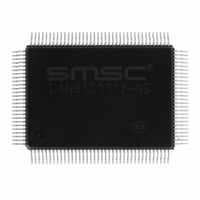LAN91C111I-NS SMSC, LAN91C111I-NS Datasheet - Page 39

LAN91C111I-NS
Manufacturer Part Number
LAN91C111I-NS
Description
IC ETHERNET CTLR MAC PHY 128-QFP
Manufacturer
SMSC
Type
Single Chip MAC and PHYr
Datasheet
1.LAN91C111-NU.pdf
(128 pages)
Specifications of LAN91C111I-NS
Controller Type
Ethernet Controller, MAC/PHY
Interface
Serial EEPROM
Voltage - Supply
3.3V
Operating Temperature
-40°C ~ 85°C
Mounting Type
Surface Mount
Package / Case
128-QFP
Product
Ethernet Controllers
Number Of Transceivers
1
Standard Supported
IEEE 802.3 or IEEE 802.3u
Data Rate
10 Mbps or 100 Mbps
Supply Voltage (max)
5 V
Supply Voltage (min)
0 V
Supply Current (max)
140 mA
Maximum Operating Temperature
+ 85 C
Ethernet Connection Type
100BASE-T or 100BASE-T4 or 100BASE-TX or 10BASE-T
Minimum Operating Temperature
- 40 C
Mounting Style
SMD/SMT
Lead Free Status / RoHS Status
Lead free / RoHS Compliant
Current - Supply
-
Lead Free Status / Rohs Status
Lead free / RoHS Compliant
Other names
638-1014
Available stocks
Company
Part Number
Manufacturer
Quantity
Price
Company:
Part Number:
LAN91C111I-NS
Manufacturer:
RECOM
Quantity:
1 000
Company:
Part Number:
LAN91C111I-NS
Manufacturer:
SMSC
Quantity:
1 000
Company:
Part Number:
LAN91C111I-NS
Manufacturer:
Standard
Quantity:
6 916
Company:
Part Number:
LAN91C111I-NS
Manufacturer:
Microchip Technology
Quantity:
10 000
10/100 Non-PCI Ethernet Single Chip MAC + PHY
Datasheet
SMSC LAN91C111 REV C
TPO±
TPO±
The AutoNegotiation algorithm is initiated by any of these events: (1) AutoNegotiation enabled, (2) a
device enters the Link Fail State, (3) AutoNegotiation Reset. Once a negotiation has been initiated,
the LAN91C111 first determines if the remote device has AutoNegotiation capability. If the remote
device is not AutoNegotiation capable and is just transmitting either a 10BASE-T or 100BASE-TX
signal, the LAN91C111 will sense that and place itself in the correct mode. If the LAN91C111 detects
FLP's from the remote device, then the remote device is determined to have AutoNegotiation capability
and the device then uses the contents of the Ml serial port AutoNegotiation Advertisement register and
FLP's to advertise its capabilities to a remote device. The remote device does the same, and the
capabilities read back from the remote device are stored in the PHY Ml serial port AutoNegotiation
Remote End Capability register. The LAN91C111 negotiation algorithm then matches it's capabilities
to the remote device's capabilities and determines what mode the device should be configured to
according to the priority resolution algorithm defined in IEEE 802.3 Clause 28. Once the negotiation
process is completed, the LAN91C111 then configures itself for either 10 or 100 Mbps mode and either
Full or Half Duplex modes (depending on the outcome of the negotiation process), and it switches to
either the 100BASETX or 10BASE-T link integrity algorithms (depending on which mode was enabled
by AutoNegotiation). Refer to IEEE 802.3 Clause 28 for more details.
AutoNegotiation Outcome Indication
The outcome or result of the AutoNegotiation process is stored in the speed detect and duplex detect
bits in the PHY MI serial port Status Output register.
AutoNegotiation Status
The status of the AutoNegotiation process can be monitored by reading the AutoNegotiation
acknowledgement bit in the Ml serial port Status register. The Ml serial port Status register contains
a single AutoNegotiation acknowledgement bit which indicates when an AutoNegotiation has been
initiated and successfully completed.
AutoNegotiation Enable
The AutoNegotiation algorithm can be enabled by setting both the ANEG bit in the MAC Receive/PHY
Control Register and the ANEG_EN bit in the MI PHY Register 0 (Control register). Clearing either of
these two bits will turn off AutoNegotiation mode. When the AutoNegotiation algorithm is enabled, the
a.) Normal Link Pulse (NLP)
b.) Fast Link Pulse (FLP)
Clock
Data
D0
Clock
Data
Figure 7.8 NLP VS. FLP Link Pulse
D1
Clock
Data
D2
DATASHEET
Clock
Data
39
D3
Clock
D14
Data
Clock
D15
Data
Clock
Revision 1.91 (06-01-09)













